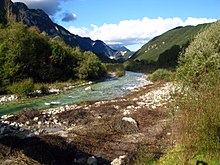Résia Valley
| Resia | ||
|---|---|---|

|
|
|
| Country | Italy | |
| region | Friuli Venezia Giulia | |
| Coordinates | 46 ° 23 ' N , 13 ° 18' E | |
| height | 492 m slm | |
| surface | 119.19 km² | |
| Residents | 944 (Dec. 31, 2019) | |
| Population density | 8 inhabitants / km² | |
| Post Code | 33010 | |
| prefix | 0433 | |
| ISTAT number | 030092 | |
| Popular name | Resiani | |
| Patron saint | San Pietro | |
| Website | comune.resia.ud.it | |
The Résiatal or Resia ( Friulian Résie , Slovenian Rezija ) is a mountain valley and a village with 944 inhabitants (December 31, 2019) in the western Julian Alps in the Italian Friuli , which of Resiutta in Fellatal (Eisental) eastward into the Ucceatal leads . The seat of the municipality is in the Prato di Resia fraction. On the way to Prato di Resia you pass San Giorgo, one of the four main towns in the valley, located on a natural terrace mid-height above the Resia. The upper Ucceatal also belongs to the municipality of Resia.
Factions
- Gniva (Njiva)
- Oseacco (Osoane)
- Prato di Resia (Ravanca)
- San Giorgio (Bila)
- Stolvizza (Solbica; it is the village of the arrotini, the scissors grinders )
- Uccea (Učja)
Neighboring communities
| Resiutta | Chiusaforte | Dogna |
| Venzone |

|
Bovec ( Goriška , SI ) |
| Gemona | Lusevera |
Ethnic particularity
About 800 people of Slavic origin live in the Resia Valley . The inhabitants derive the name "Resianer" from " Russians ". Their dialect Resian has common roots with the Slovene dialects of Carinthia, but later, after the linguistic connection to the Canal Valley was interrupted by Friulian and German colonization, it leaned on the coastal dialects ( primorsko ) of Slovene.
From the Resia valley a road leads over the Carnizzasattel into the Ucceatal , which is also inhabited by Resians, and on to Zaga in the Soča valley and to Slovenia .
music and dance
Due to the isolated location, very independent musical traditions were formed or maintained in the Resia Valley: the dance melodies with their small range and frequent metric irregularities, mostly played alternating between two quint-related keys, are of particular importance. A common line-up is two (rarely just one) violins ("Citira") that play the melodies in unison, as well as a three-string cello ("Bunkula"), which is a simple drone accompaniment as a bass instrument . Especially in the carnival season and on August 15th ( Assumption of Mary ) these traditions are still alive. Because of their peculiarities and the presumably old age, dance music and songs from Resia have gained outstanding importance in the repertoire of the folk revival in Slovenia and Friuli (groups such as Katice or La Sedon Salvadie).
Attractions
- Scissor Grinder Museum in Stolvizza.
- At the entrance to the village there is a monument on which a scissors grinder is sitting on his bicycle.
- Once a year, the grinders scattered around the world or their descendants meet at the big village festival in Stolvizza.
- A multimedia folklore museum is located right next to the church .
- Lime kilns
- Church of the Assumption in Prato
- Fresco painting Crucifixion on the side wall of an old house in Stolvizza
literature
- Julijan Strajnar: Citira. La musica strumentale in Val di Resia. Instrumentalna glasba v Reziji . Pizzicato, Udine 1988, ISBN 88-7736-101-8
- Kurt F. Strasser, Harald Waitzbauer : Across the borders to Trieste. Hikes between the Carnic Alps and the Adriatic Sea. Böhlau Verlag, Vienna / Cologne / Weimar 1999
- G. Pilgram, W. Berger, W. Koroschitz, A. Pilgram-Ribitsch: The last valleys - hiking and stopping off in Friuli . Drava Verlag, Klagenfurt / Celovec 2008, ISBN 978-3-85435-532-8
Web links
Individual evidence
- ↑ Statistiche demografiche ISTAT. Monthly population statistics of the Istituto Nazionale di Statistica , as of December 31 of 2019.





